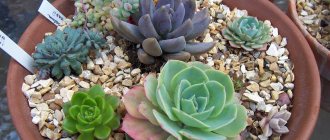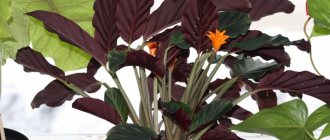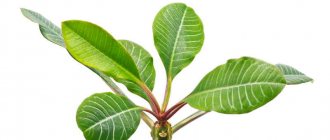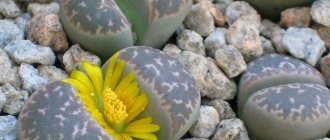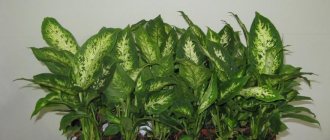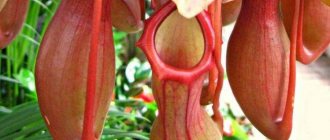Echeveria agave. Photo Echeveria or stone rose , as it is also called because of its external resemblance to the flower, is an exotic succulent plant that does not require much attention . A warm, well-lit place is the basic requirements of the plant. In return, it will add a hot desert “zest” to any interior.
It is a perennial succulent plant from the Crassulaceae family, with about 150 species. Echeveria is native to Central and South America.
The rosette, with a diameter of 10 to 40 cm, is shaped like a rose. It grows slowly: it produces several new leaves and daughter rosettes per year. The root system is superficial. Fleshy, dense leaves reach 3-20 cm in length, 1-15 cm in width, and have an oval shape with a sharp end. The leaf blade may be glossy or slightly pubescent. Depending on the species, the foliage color is green, bluish-gray, reddish or violet-pink.
| It grows slowly: it produces several new leaves and daughter rosettes per year. |
| It blooms mainly in spring or summer, some varieties in winter, for 2-3 weeks. Bell-like flowers are collected in inflorescences on a long peduncle. |
| The plant is easy to grow. |
| Perennial. |
Botanical description of the plant with photo
Echeveria or Echeveria is a succulent plant belonging to the Crassulaceae family.
The perennial has several distinctive features:
- may be stemless or have a stem reaching a height of 70 cm;
- some species are distinguished by creeping shoots;
- the root system is not buried, but grows superficially;
- in most species, the leaves are quite dense, hard, saturated with moisture, because of this the plant gives the impression of being made of stone;
- the leaf plates are oval in shape with a pointed tip, their length reaches 30 cm, width - 15 cm;
- the color of the leaves is quite varied: violet-pink, wine-red, gray with a blue tint, all shades of green;
- there is pubescence on the leaf blades or a coating similar to frozen wax;
- the rosette in which the leaves are collected can be dense or loose;
- The peduncle can be lateral or vertical and reach a height of up to 50 cm;
- the color of the peduncle depends on the light: in bright light it is red-orange, in dim light it is yellow;
- the flowers are small (up to 30 mm) five-membered bells, collected in erect inflorescences.
Types grown at home (table)
Of the many representatives of the species, most are suitable for indoor floriculture. But for various reasons, only a few dozen are the most common.
| View | Description |
| Agave (agavoides) | The stem of this bush-like plant, reaching 25–30 cm in height, is very short or completely absent. The leaves are delicately lettuce, translucent at the edges, with a noticeable reddish tint. At home, the leaf length is 4–10 cm, width is 5–6 cm. The plant blooms in late spring. The flowers are very small (1–1.5 cm), all shades of yellow-red. Very rarely, several inflorescences have pink coloring. |
| White-haired (leucotricha) | The name of the subshrub is due to the presence of a thick white edge, reminiscent of a long pile. Small (12–15 cm in diameter) rosettes are composed of lancet-shaped leaves with a brownish border. The flowers are bright red. Artists know this shade as cinnabar. |
| Shiny (fulgens) | A characteristic feature of the subshrub is not too intense branching. If shoots are formed, they are short and very thick. Inflorescence in the shape of a brush or umbrella. Bright scarlet flowers appear in late winter or early spring. |
| Gibbiflora | Of all the echeverias, it most closely resembles a tree. Stems are erect, sometimes slightly branched. Rosettes of grayish-green leaves with a brick or brown tint are located on the tops of the shoots. The leaf plate is similar to a lens - it is concave at the top and convex at the bottom. The leaves are large - 20–25 cm long, 10–15 cm wide. At the end of summer, the plant produces a tall (up to 1 m) peduncle. Inflorescence in the shape of a spike. The flowers are muted scarlet on the outside, yellowish on the inside. Many hybrids have been bred through selection. The most famous are carunculata (the leaves are covered with small tubercles, as if twisted), crispata (the leaves with corrugated edges are silvery) and metallica (leaves with a whitish or reddish border have a tint of old bronze or purple). |
| Derenbergii | Herbaceous plant. The shoots spread along the ground, small (4–7 cm) rosettes of leaves are located at their tops. The length of the leaf is almost equal to the width (3 and 2.5 cm). The leaves are covered with a bluish coating, with a reddish tint visible along the edges and at the tip. The inflorescences are short (5–6 cm), spike-shaped. The flowers are yellow-orange or reddish. |
| Elegant | Herbaceous perennials. The leaves are a very light green shade, almost white. The edges are see-through. The tip is pointed, sometimes even prickly. A characteristic feature is a highly branched peduncle. The inflorescences are drooping, in the form of small one-sided racemes. Flowers are crimson, turning yellow. |
| Lau (Lauii) | Unlike other species, it does not grow too quickly and is quite demanding in care. One of the largest rosettes (18–20 cm in diameter). The leaves are diamond-shaped, almost white due to a thick layer of waxy coating. The orange-pink shiny flowers are also covered with it. |
| Pillow-shaped (pulvinata) | Low-growing (18–20 cm) subshrubs. The rosette is quite “loose”, there are few leaves in it. At the top of each leaf there is a short spine. The leaves and yellow-red flowers are pubescent. Inflorescences are spike-shaped. |
| Shaw (Shaviana) | Not too similar to echeveria at all. The leaves are almost round, soft to the touch, corrugated along the edges. They are compressed so that the rosette looks more like a head of cabbage rather than a flower. It produces several flower stalks at the same time, the pinkish flowers on which bloom alternately. |
| Bristly (setosa) | The bush-like plant forms many shoots. The rosettes are in the shape of an almost regular ball, each of them has more than a hundred dark green leaves with a grayish tint. The leaves are densely covered with white bristles - hence the name. The inflorescence is low - about 30 cm. The shape of the flowers resembles miniature tulips, and the color too. |
| Linguaefolia | A low (20–25 cm) subshrub forms two (no more and no less) fleshy trunks. The peduncle is drooping, sometimes branches from below. The flowers are light yellow, straw-colored. |
| Purple (atoropurpurea) | The rosette is large, but loose. It is located at the top of a stem about 15 cm high. The leaves are also large (up to 12 cm), brick-colored. |
| Purple (purpusorum) | Very original color and shape of the leaves. They are thick, wide, with a very sharp end, becoming noticeably thinner towards the edges. The rosette is located at the top of a short thick stem. The leaves are olive, with rich purple spots. |
| Echeveria Harmsii | The leaves are very small, in the shape of a rounded diamond. At each point, the leaf blade turns red. The flowers are small, reddish-yellow. |
| Desmetiana | The leaves have a pronounced bluish tint. The rosette is located at the top of a long stem. Blooms from mid-July. Inflorescences are formed on the side shoots. |
| Multi-stemmed (multicaulis) | Tall stem (up to 1 m). The leaves are small, slightly concave, dark green, with a red border. The rosette in the center is dense, becoming noticeably looser towards the edges. The flowers are yellowish inside, scarlet outside. |
| Gray (glauca) | Compact plant with small dense rosettes. The leaves are wedge-shaped at the base and become pointed towards the tip. They are covered with a thick layer of bluish coating. |
| Miranda | A very impressive plant with neat small rosettes that seem to be lying on the ground. They are very similar in shape to a lotus. Varieties with bluish, violet, pink, scarlet, yellowish, and silvery leaves have been bred through selection. |
| Black Prince | Selective hybrid. The leaves are green at the base and change color to dark purple at the tips. From a distance it can even be mistaken for black. The flowers are small and scarlet. |
| Pearl of Nuremberg (Perle von Nurnberg) | Selective hybrid. The stem is thick and straight. The leaves are pinkish-gray, the youngest ones are pastel pink. The flowers are muted scarlet. |
Photo gallery: Echeveria varieties
The youngest leaves of Echeveria Brilliant sometimes have notched edges. Echeveria White-haired blooms profusely throughout the spring. Echeveria hump-flowered is an excellent basis for breeders’ experiments. The reddish tint of the leaves of Echeveria Agave-shaped becomes richer as the plant matures. Because of its decorative nature, Echeveria Miranda is most often found in indoor floriculture Echeveria Purple cannot be confused with other species of Echeveria Multistem intensively branches from the very base Echeveria Black Prince is one of the most beautiful breeding hybrids Echeveria Purple is actually not quite purple, but it sounds beautiful Because of the thick layer of bloom, the leaves of Echeveria Sizoy seem almost white Echeveria The pearl of Nuremberg was bred on the basis of Echeveria humpbacked flower The stem of Echeveria Garms practically does not branch Echeveria Bristleflowers blooms very profusely If the winter was warm, in nature the flowering of Echeveria Tongue-shaped can move from April to January or February The bottom leaf plate of Echeveria Cushion-shaped is slightly convex Echeveria Desmeta is one of the most enduring in relation to the lack of light and excess moisture The waxy coating on the leaves of Echeveria Lau is thick, but is easily erased Over time, the stem of Echeveria Graceful lies under the weight of the leaves, the rosette quickly takes root. Unlike the others, Echeveria Derenberg has only 3-5 flowers in the inflorescence. In winter, Echeveria Sho, will most likely lose most of its leaves
Indoor varieties of echeveria
Of the 200 existing species of echeveria, a sufficient portion of them grow well at home. Most Popular:
- agave;
- hump-flowered;
- The Pearl of Nuremberg;
- bristly;
- Lau et al.
They all differ in botanical characteristics and color, so many gardeners prefer to grow several varieties at the same time.
Find more information about varieties and hybrid varieties of the plant here.
Origin story
This succulent is native to Mexico. It is also found in the United States and Peru; some species were found in the Caucasus mountains.
Echeveria was first mentioned in scientific works in the 19th century . However, by that time the plant had long spread throughout the world thanks to trade relations. The stone rose was grown in the palaces and gardens of wealthy aristocrats, it was added to the bouquets of court ladies, and used as decoration for dresses, hats, carriages, and so on.
Temperature
Echeveria is a heat-loving plant that thrives even in very hot conditions. During its growth period, room temperature is recommended. Since the flower loves daily temperature changes, the appropriate indicator for it in the daytime is from +22 to +26 °C, at night - from +10 to +16 °C.
In winter, the air temperature in the room with echeveria should be no higher than +13 °C and no lower than +7 °C.
Wintering in cool and dry conditions will have a beneficial effect on bud formation. Otherwise, the absence of a dormant period will significantly weaken the plant.
Reviews from flower growers
My flowers are all on the windowsill, which is located on the sunny side and not all flowers survive there.
Today all that remains are the Crassula, a couple of geraniums, mother-in-law's tongue and cacti. Caring for it (Echeveria - editor's note) is minimal, water it and occasionally loosen the soil. It is growing at a good speed and I think in a month or two it will be necessary to transplant it into a larger pot. Today I already have three plants, two are currently blooming, one is a baby. I bought more while we were in the store, and I don’t regret it at all. Other flowers die, but my echeverias grow and bloom. Idealnaya
https://irecommend.ru/content/krasivaya-i-ne-prikhotlivaya-0
I bought it in January, I have it a little different than on the screensaver: plum color, with a bluish waxy coating, and the shape of the leaves is different.
In summer it is very bright, almost amethyst, but in winter it turns pale. She lived on my eastern window, but there was little light, and as a result my “rose” grew to be 12 cm tall. The spectacle was not very attractive, it began to get more light, the top became denser, but the bottom was still bald and loose. The result was cabbage on a stalk. Smile) And then in April a friend came to see me. I gave the top with 6-7 leaves to this pest, but it was a pity to throw away the stem with 4-5 leaves, so I planted it back in the pot. And she left for a month. I arrive, and there is such a multi-headed monster formed Smile) <…> I like this tree even better. I’ll probably take note of this “barbarism” Smile) Varvara Savelyeva
https://irecommend.ru/content/moi-pyatiglavyi-zmei-gorynych
It always stands in a sunny window, watered as the soil dries.
Doesn't demand anything, doesn't get capricious, doesn't get sick. Over time, my flower turned into a gray-blue cap on a stem, but one day, several years later, she surprised and gathered the whole family around her! Our flower shot out an arrow with the same “dusty” leaves, only sparser. “It started to branch,” we decided, but after a few days “dusty” orange bells appeared on the arrow! With sharp edges and some fabulous golden stamens! We were stunned! And now it blooms constantly! It's been 7 years already!!! And it continues to grow! Any leaf that falls into the ground from it immediately germinates, so there will be no problems with its reproduction!))) A funny, but constantly blooming resident of our windowsill! Love her! ALTAIR_85
https://irecommend.ru/content/pylnaya-lyubimitsa-foto
How often and correctly to water?
Echeveria tolerates drought conditions well and does not like even slight waterlogging of the soil. Therefore, watering is permissible only after the earthen clod has thoroughly dried to 1/3 of its depth. Excess moisture that appears in the pan is immediately removed.
Recommended frequency:
- in spring and summer – once a week;
- in autumn and winter - once a month.
For irrigation, use well-settled or rainwater.
To avoid moisture getting on the leaves, leading to rotting, this procedure is carried out using a watering can with an elongated spout.
What kind of pot is needed to grow a flower?
The container for planting echeveria should be 1.5-2 cm larger than the diameter of the plant itself and have drainage holes. Due to the shallow root system, a low and at the same time wide pot would be an ideal option.
Experienced flower growers recommend purchasing ceramic or clay containers that allow moisture and air to pass through perfectly. When giving preference to plastic products, it is worth remembering their ability to heat up quickly, which negatively affects the condition of the root system.
Flowering time
Young plants bloom in the third year, almost all species die after flowering, but manage to give life to a large number of young plants (this explains its Latin name, which translates as “always living”).
- Flowering begins in mid-summer and lasts a little over a month.
- Juveniles rarely bloom at home, so quite old specimens are also found.
- How does the young bloom? The photo of the plant looked young.
By the end of July-beginning of August, red flowers collected in inflorescences bloom on long peduncles, often reaching a height of 60 centimeters; distributed throughout Europe, in Asia Minor, on high hills along river banks, it can also be seen in Africa;
Reddish flowers appear on peduncles up to 30 cm in size in mid-summer; has several cultural varieties and is widely used to create garden compositions;
Priming
Echeveria prefers loose soils with little nutritional value. For planting, you can purchase an industrial composition for succulents or prepare the substrate yourself.
It is recommended to add fine brick chips and river sand to store-bought soil, and crushed charcoal to prevent root rot.
To prepare your own substrate you will need:
- turf soil - 1 part;
- dry clay – 1 part;
- coarse sand – 1 part;
- leaf soil - 2 parts;
- drainage.
Transplantation after purchase and more
Young plants (under 3 years of age) are replanted once a year, and subsequently once every 3-4 years. The optimal time for this event is spring.
The process includes several stages:
- Place a layer of drainage at the bottom of the prepared container; for this purpose, you can use broken brick, expanded clay or crushed clay shards.
- Fill the drainage layer with substrate and place the flower in the center of the pot.
- Sprinkle fresh soil around the perimeter of the plant, using your fingers to remove any air pockets that form.
- At the final stage, surround the root collar of the echeveria with small pebbles or a layer of coarse river sand to improve the outflow of moisture.
Leave the transplanted plant for 7-10 days in a shaded place.
Where to plant?
Echeveria mix is transplanted into a container with suitable soil.
It should conduct water well. The stones at the bottom (broken brick or gravel - about 5 millimeters in size) are evenly mixed with the soil. Sand and vermiculite should not be taken.
Land intended for cacti is suitable for the mix . You can plant it both in open ground and in a florarium. Shallow but wide pots with a hole in the bottom are ideal.
When making a florarium, a glass container is filled with a drainage layer, after which a layer of soil for the mix is laid out. The bushes are carefully planted (we recommend using tweezers) and watered from a small watering can. The empty spaces between the succulents are filled with selected decorative elements.
Reproduction
In indoor conditions, echeveria can be propagated in almost all available ways.
Sowing seeds
The process of growing from seeds is considered the longest, as it takes up to 3 months.
Seeds for sowing can be purchased at the store or collected yourself. They are scattered over the surface of a flat container filled with a mixture of peat and sand (1:1), lightly pressed down and moistened with a spray bottle. Cover the top with plastic film or glass.
For 15-20 days it is necessary to maintain temperatures of about 25 degrees. When the seeds germinate, the film is removed. The seedlings are transplanted after 2-3 months.
Leaf
Algorithm of actions:
- Cut off a healthy leaf.
- Dry: 14-20 days for a fleshy plate, 2-3 hours for a thin specimen.
- Press the sheet with the cut inward onto the prepared soil.
- Moisten with a spray bottle and cover with film.
- Maintain the temperature in the greenhouse at +25 °C.
As a rule, when breeding using this technology, babies appear in 2-3 weeks.
Rosettes
This method is considered the most effective - echeveria throws out the first flower stalks within a year. Replanting a rooted rosette is recommended after 2 months, or within a year in case of slow plant growth. The algorithm of actions is the same as when rooting a leaf.
How to root with the top?
Typically, rooting with apical cuttings is carried out after the lower leaves have completely fallen off, as a result of which the plant becomes inconspicuous. The planting method is identical to leaf planting. When propagated in this way, the cuttings buried in the soil begin to grow in about 20 days.
Preparatory stage
Echeveria is southern in origin; South and Central America and Mexico are considered its homeland. Therefore, in order to grow a succulent, it needs to create conditions that will be as close to natural as possible .
Deadlines
Each plant, just like a person, has its own biological rhythm. In Echeveria, the active growth phase is observed in the spring-summer period. And from October to February, the stone rose goes into a dormant state. Given such rhythms, experts recommend starting to plant seeds in late February - early March.
Flower growers do not recommend disrupting the biological clock of the plant , but if there is a great desire to admire echeveria in winter, then you can postpone the planting to September-October. In this case, it is necessary to take care of special, greenhouse conditions, implying a sufficient amount of heat and light in severe frosts.
Container and soil for planting
Particular attention should be paid to the soil. To make seedlings feel comfortable, gardeners recommend taking into account the following points :
- For planting, you can use conventional mixtures that contain a coarse mineral base (fine gravel, sand, agroperlite). It is recommended to add a small amount of granular or crushed coal to such soil.
- A composition that includes equal parts of the following components is considered successful for the development of echeveria: universal peat filler (slightly acidic humus), perlite, sand, crushed coal.
Any soil components can be purchased in specialized stores or taken from a garden plot or in the forest. But soil obtained from natural conditions must be disinfected using disinfectant solutions , steaming or frying procedures.
Material for sowing
To guarantee the germination of your seeds, you need to use several recommendations from professionals:
Seed selection . When selecting raw materials for planting, you must pay attention to the packaging date. Seeds that are no more than one year old germinate best. With each subsequent year, the germination rate of raw materials decreases significantly.- Seed disinfection . To eliminate the risk of developing fungal diseases in the plant, the seeds are placed in a weak solution of potassium permanganate for one day.
- Activating growth . You can buy special growth stimulants in flower shops. They enhance and accelerate the process of seed germination. The raw materials are soaked in such solutions (depending on the instructions) for 1-2 hours.
Diseases and pests
Ignoring the rules of agricultural technology can cause the development of the following diseases:
- dry rot;
- root rot;
- powdery mildew.
When the first signs of disease are detected, the plant is treated with a fungicide.
Echeveria is susceptible to attacks from pests such as:
- root-knot nematode;
- root mealybug;
- mealybug.
To combat harmful insects, the flower is treated with an insecticide.
Similar flowers
The following species resemble Echeveria Miranda:
- Sempervivum from the Crassulaceae family has dense, small leaves collected in a rosette.
- Lotus - has a similar flower shape.
- Aeonium (tree-like succulent) - has a pink rosette and dark green shiny leaves.
- Haworthia (dwarf plant) - folds the foliage into a rosette.
- Aloe (succulent) - has a similar leaf shape, forming a rosette.
Echeveria Miranda is a popular houseplant that does not require complicated maintenance. It is easy to grow or propagate such a flower if you take into account the basic rules and recommendations. Attention should be paid to the temperature regime, the amount of watering, soil mixture, and fertilizing. With proper care, a stone rose will delight you with its beauty and long life.
Possible problems
Often the poor condition of echeveria is caused by non-compliance with the watering regime or improper lighting.
What to do if you are stretched out?
Stretching of a flower indicates a lack of sunlight. The problem can easily be eliminated by moving the pot to a more illuminated place.
Why did you lower the leaves down?
Drooping leaves that have lost their original elasticity indicate dehydration of the soil. In this case, the substrate must be moistened by adding liquid complex fertilizer to the water, and then strictly adhere to the watering regime.
Also, the reason for drooping leaves may be low room temperature or stagnation of water in the root system.
The lower plates fall off and turn yellow
Yellowing and falling of leaves is associated with stagnation of water in the pot. To eliminate the problem, it is recommended to completely replace the soil.
The socket is rotting: how to save it?
If the socket rots, first of all you need to give it a chance to dry. In the future, it is recommended to transplant the plant into another soil, cutting off the damaged lower leaves and fragments of the root system.
Common mistakes in care
Echeveria, of course, is not picky and undemanding, but mistakes in care have a detrimental effect on its decorative properties.
Table: common mistakes
| Description of the problem | Probable Cause |
| Dark spots on leaves. | Drops of water got on the plant or you yourself erased the wax coating, for example, during transplantation. |
| The leaves and stem at the base turn black and are easily separated from the plant. | The echeveria is too cold and/or you are watering it too much. If more suitable conditions are not created, rot that begins to develop will quickly destroy the plant. |
| Leaf deformation. | Exceeding the permissible concentration of fertilizers or using hard water for irrigation. Another option is a reaction to insecticides. If possible, use only those whose main active ingredient is pyrethrum. |
| The stems become elongated, the leaves turn pale, and the rosettes become less dense. | The plant lacks light and warmth. Find him a more suitable place and gradually (over 10–12 days) accustom him to new conditions. |
| The leaves are getting smaller. | Echeveria is cramped in a pot. After the next dormant period, replant the plant. This is also a characteristic sign of insufficient or too infrequent watering. |
Echeverias react quite negatively to mistakes in care, losing their decorative properties.
How to create a mix composition?
The process of creating a composition with echeveria includes several manipulations:
- Choose a suitable container.
- Lay out in successive layers:
- drainage expanded clay;
- soil diluted with vermiculite/perlite;
- moss.
- Arrange the succulent cuttings so that there is room for further growth.
- Lay out decorative elements: pebbles, shells, figurines, etc.
- Water without allowing water to get on the leaves of the plant.
When creating a mix composition, it is important to use succulents with similar habitat requirements.
What is important when choosing seed?
Planting material plays an important role in growing plants. Therefore, the choice of seeds must be taken responsibly:
- Be clear about the type of plant.
- Buy seeds in branded packaging from a trusted manufacturer.
- Choose only those seeds whose packaging contains detailed information about them.
- Check the expiration and sale dates of seeds.
- Do not buy seeds with a reserve.
